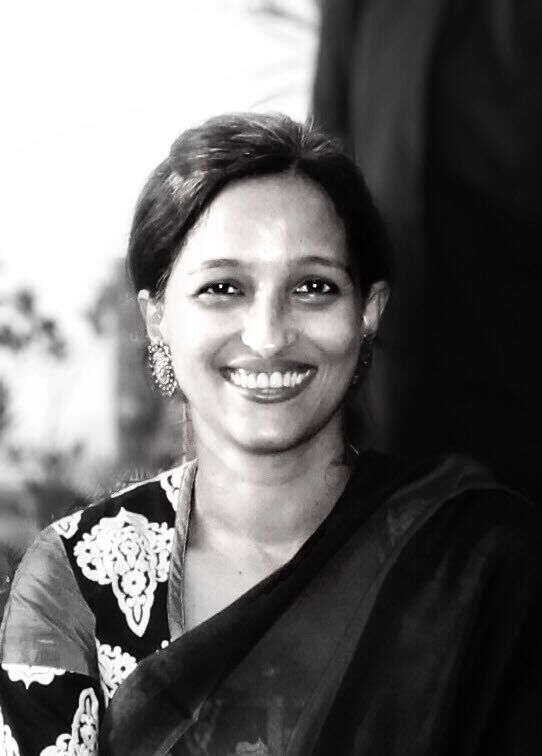India has no shortage of billionaires. We added 17 new ones in 2017 alone, taking the count up to 101. During the same year, the wealth of this elite group increased by INR 20,91,300 crore—an amount equal to total budget of Central Government in 2017-18.
There is another list that tracks how the rich have fared in India year after year—the Hurun India Rich List which looks at people with a wealth of over INR 1,000 crore. In 2018, 831 individuals made it to this list 1—a 35 percent increase from last year and a jump of 100 percent since 2016. The average wealth on the 2018 list was around INR 5,900 crores.
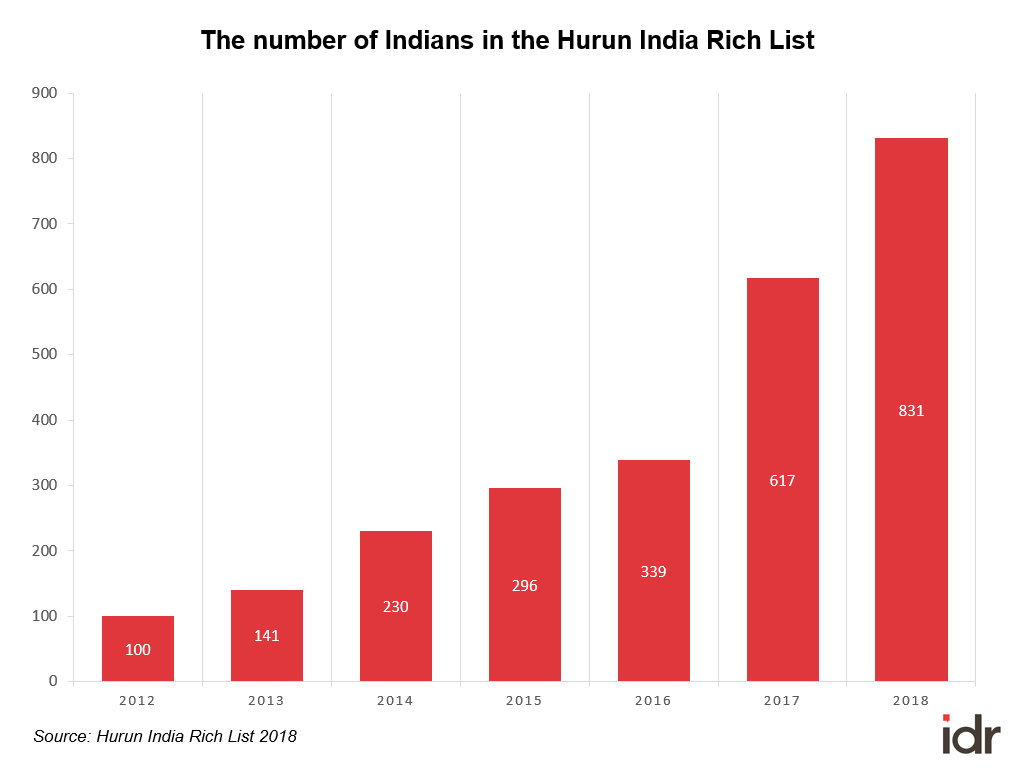
Figure 1
When it came to philanthropy though, only 38 men and one woman made it to their annual Hurun Indian Philanthropy List 2018 2, which looks at Indians who have donated INR 10 crore or more in a 12-month period.

The amount donated by Mr Ambani equals 0.1 percent of his wealth.
Mukesh Ambani who topped the India Rich List with a net worth of INR 3,71,000 crore was ranked number one on the Philanthropy List as well, having donated INR 437 crore towards education, healthcare, and rural development; the amount donated equals 0.1 percent of his wealth.
This is also the first year Mr Ambani has made it to the top of the Philanthropy List despite having topped the Rich List for the seventh year running.
While the number of Indians giving more than INR 10 crore during the year rose from 27 in 2016 to 39 in 2018, the average donation size actually reduced from INR 86 crore to INR 40 crore.
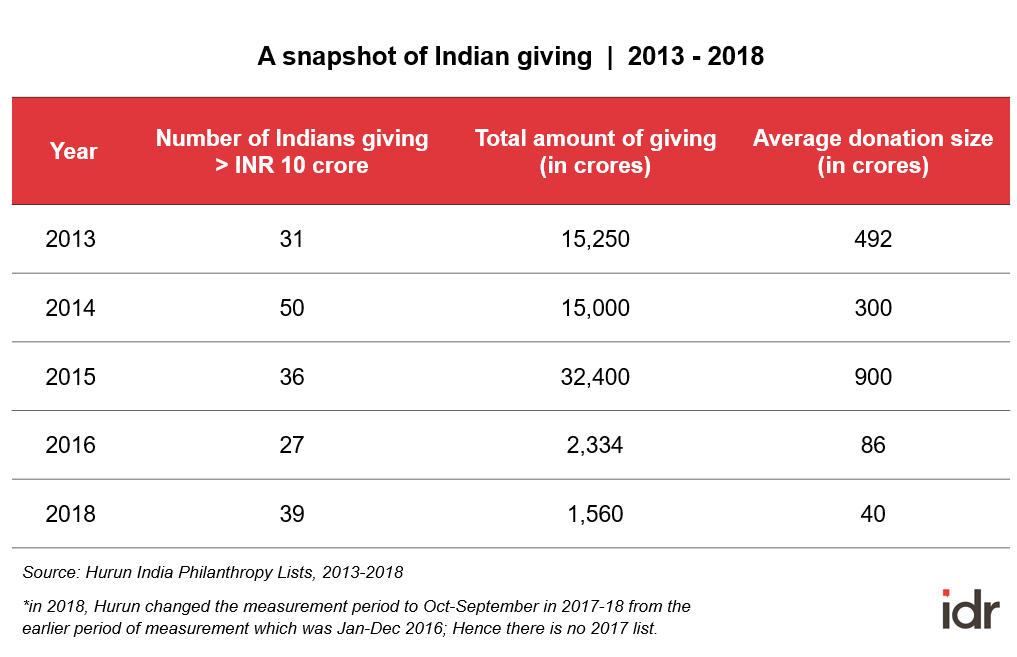
Figure 2
Mr Azim Premji to the rescue
Over the years, Azim Premji has single-handedly shored up these numbers: He gave INR 8,000 crore in 2013, INR 12,316 crore in 2014 and INR 27,514 crore in 2015. Without his contribution, the data would look as follows:
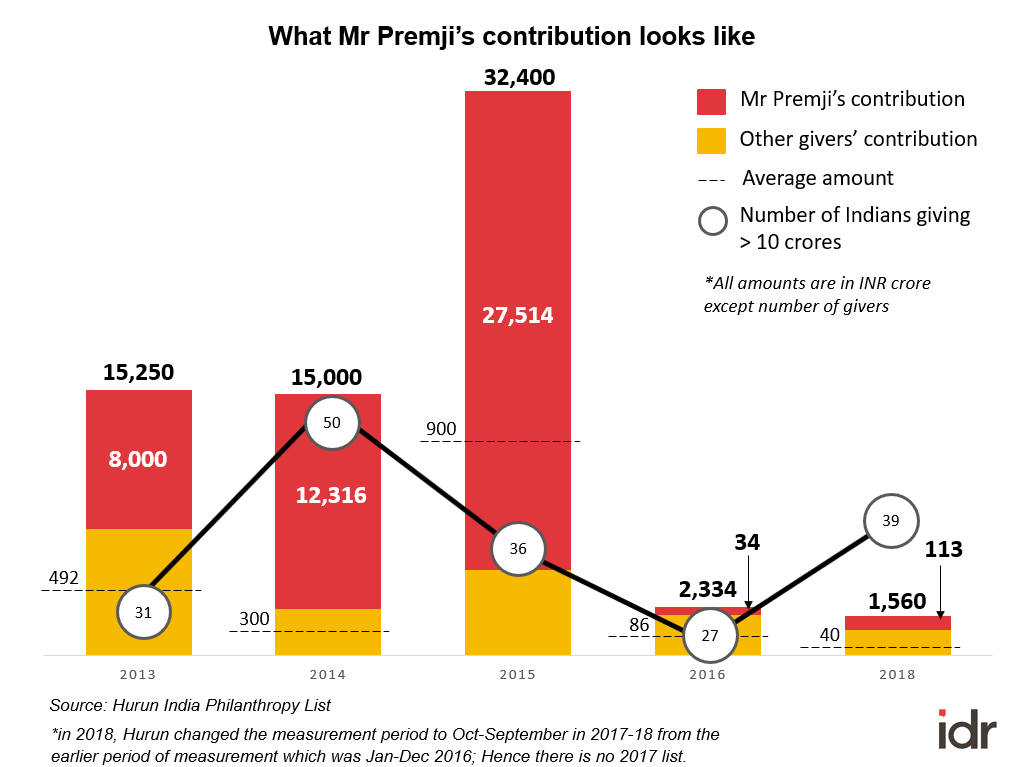
Figure 3
The data paints a picture contrary to the general perception that as our people get wealthier, they are likely to become more generous.
The data is eye-opening. Despite its limitations 3—it uses CSR data as a proxy for giving and only captures giving over INR 10 crore—it paints a picture that runs contrary to the general perception in the country—that as our people get wealthier, they are likely to become more generous.

To drive home the point: in 2018, while we had 831 men and women whose average wealth was INR 5,900 crore, only 39 of them gave an average of INR 40 crore (or 0.68 percent of their wealth), and most of them did it via their companies.
How we compare against China
When we compare ourselves to China, as we are wont to do with different aspects of our country’s performance—be it the rate of economic growth, the state of infrastructure, population and demographics, or even just the number of billionaires—we come off looking even worse.
In 2018, China had 100 philanthropists who gave more than INR 17 crore each year. Of these 13 were women. The average donation amount was INR 230 crore.
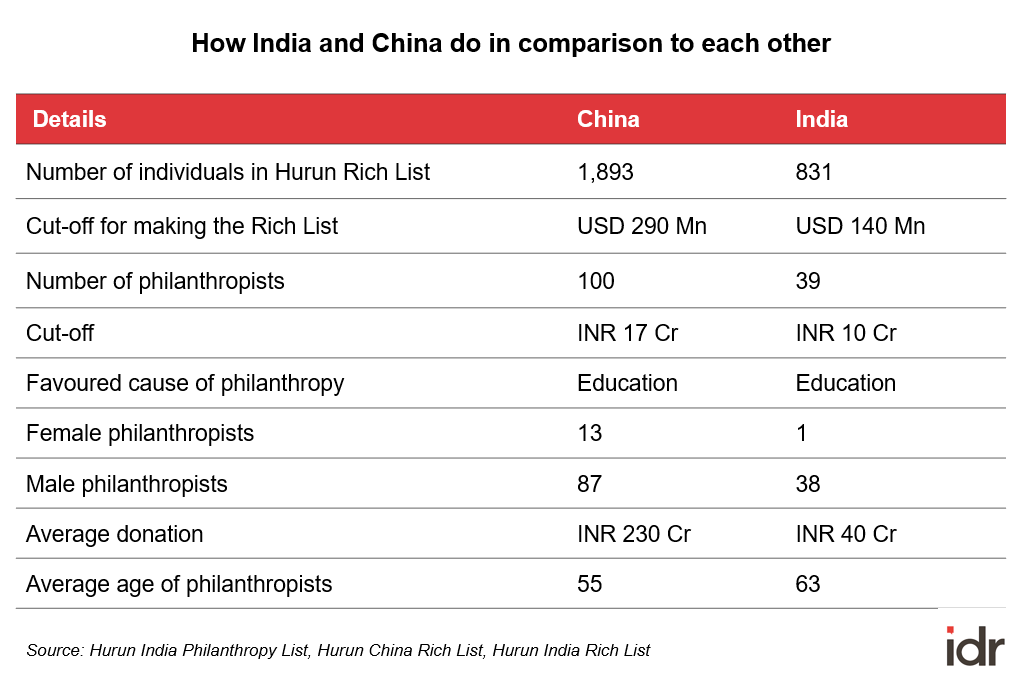
Figure 4
So, is philanthropy in India really growing?
The Bain India Philanthropy Report 2017 that is so often quoted by everyone who writes about the exponential growth in private philanthropy in India, contains the following data:
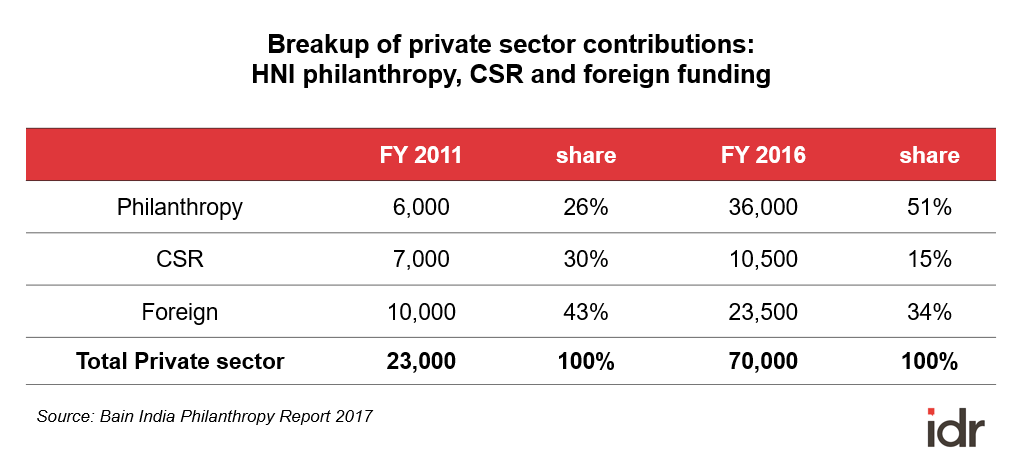
Figure 5
The number that gets everyone excited and optimistic about Indian philanthropy is the INR 36,000 crore number in 2015-16 contributed by individual philanthropy. It shows a 6X jump from the 2011 data, the highest when compared to others—CSR at 1.5X, foreign funding at 2.4X.
However if one breaks down the INR 36,000 crore in the period April 2015-March 2016, it is highly likely that INR 27,514 crore came from Mr Premji alone 45; which means that other Indian philanthropists gave just around INR 8,500 crore. When this number is compared to INR 6,000 crore in FY 2011, the jump is more modest at 41 percent and lower than the pace at which CSR and foreign funding grew, during that five year period.
The question then to ask is: Is the philanthropic market actually growing? Or is it dependent on the same few individuals and foundations who give generously year after year?
For a country that is estimated to produce 70 new dollar millionaires (people with a net worth of INR 7 crore) every single day between 2018 and 2022, the question to ask is what can we do to encourage many of them to become philanthropists?
If you can’t measure it, you can’t improve it
As a starting point, we need to do more around tracking giving in India at different levels. While Hurun attempts to cover giving by the very rich, research and consulting firm, Sattva, is attempting to track everyday giving by ordinary citizens. We need data for individuals in the vast middle (who earn between INR 50 lakh to 100 crores annually), and who have the potential to give between INR 1 lakh to INR 5 crore every year.
We need to do more around tracking giving in India at different levels.
The last report that came closest to this was the Bain India Philanthropy Report 2015, which surveyed 377 individuals. However, 49.1 percent of these were people who gave between INR 50,000–INR 1 lakh—still relatively smaller ticket. Since then, their subsequent reports 6 have been based on data drawn from interviews and surveys with a much smaller sample size of 33-46 ultra-high net worth individuals.
Ashoka University’s Centre for Social impact and Philanthropy (CSIP) has made a start by looking to scrape data from large databases (Union Budget documents, Ministry of Home Affairs, Income Tax Department, NGO Darpan, and Ministry of Corporate Affairs) to pull together data on different types of giving. While they have succeeded in compiling and analysing data for foreign funding and CSR, they acknowledge that ‘Individual giving remains the biggest missing piece in estimating the total volume and value of philanthropic capital in India’.
We need to look beyond ‘high net worth’ philanthropists
Conversation and media attention around philanthropy in India has tended to focus almost entirely on the ultra-wealthy and CSR. However, the former do not seem to be too keen on giving, while the latter will continue to plod along and grow steadily as mandated by the law.
As a sector we have done almost nothing to grow the mass-market—the everyday givers.
Maybe it’s time to focus on smaller-ticket individual giving or retail giving. At the moment, the data on this front isn’t too encouraging either. According to the World Giving Index 7 that is released each year by Charities Aid Foundation, India was ranked 124th among 144 countries in 2017; this has been our worst performance in the last five years 8. We have also consistently been at the bottom of the heap when compared to all our South-Asian neighbours 9.
However, given the attention and money that has been channelled to build high-value philanthropy, as a sector we have done almost nothing to grow the mass-market—the everyday givers. In the US, individuals accounted for 70 percent of all giving.
In India there are almost no organisations, other than voluntary initiatives like DaanUtsav, that serve as market-makers for people to give. While organisations like GiveIndia and crowdfunding platforms like Ketto, Smallchange.ngo, and Milaap seek to ‘tap’ the market, they don’t have the wherewithal to ‘grow’ the market.
Just as foundations, the likes of Omidyar Network, Bill and Melinda Gates Foundation, USAID and others, have invested in intermediary organisations to build the ‘strategic’ philanthropic market, we need institutions and foundations—who are interested in growing and strengthening domestic philanthropy—to invest in inspiring people to give, building campaigns and awareness around causes, and improving the retail-giving infrastructure.
The limited data we have shows that there is almost no link between the growing wealth in our country and the amount people give via philanthropy. And, left to itself, domestic Indian philanthropy—whether retail or high-value—is unlikely to grow in the manner in which we would like it to.
For that to change, we need more data, new strategies, different approaches, and more organisations that can build new giving markets. Without this, we will fail in our attempts to support civil society in the manner that they truly deserve.
- The Hurun Indian Philanthropy list 2018 ranked all Indians who donated INR 10 crore or more between October 2017-September 2018.
- Wealth calculations are a snapshot as on July 31, 2018, the same date as previous years.
- To make this list, the Hurun Report surveys 800 of India’s most successful entrepreneurs, including those from the Hurun India Rich List, meticulously cross referencing the results with media reports and charitable foundations. The report includes cash and cash equivalents pledged with legally binding commitments for the twelve month period under review. The report also includes donations made by companies in which an individual had a significant share by applying the percentage the individual has of the company on the donations.
- The Bain India Philanthropy Report does not provide the breakup of the Rs 36,000 cr for FY 2016 (April 2015-March 2016); It states: “A large portion of this amount has come from a few established givers who have pledged large sums of their net worth to philanthropy.”
- Mr Premji announced his decision to give away an additional 18 percent of his stake in Wipro in July 2015; the Hurun List 2015 that estimated the INR 27,514 crore tracked giving between November 2014 and October 2015.
- The Bain India Philanthropy report 2017 surveyed 33 individual philanthropists and Dasra conducted in-depth interviews with 23 philanthropists; the 2018 report was drawn from interviews with 33 philanthropists.
- World Giving Index of global generosity tracks how people across the world give money, volunteer, or help a stranger in need.
- CAF ranking for India was 81 during 2016, 91 during 2015, and 106 during 2014.
- While India is usually on top of the list in terms of sheer numbers (because of the size of the country), it fares poorly in terms of rankings because that is a measure of people giving as a percentage of the country’s population.

